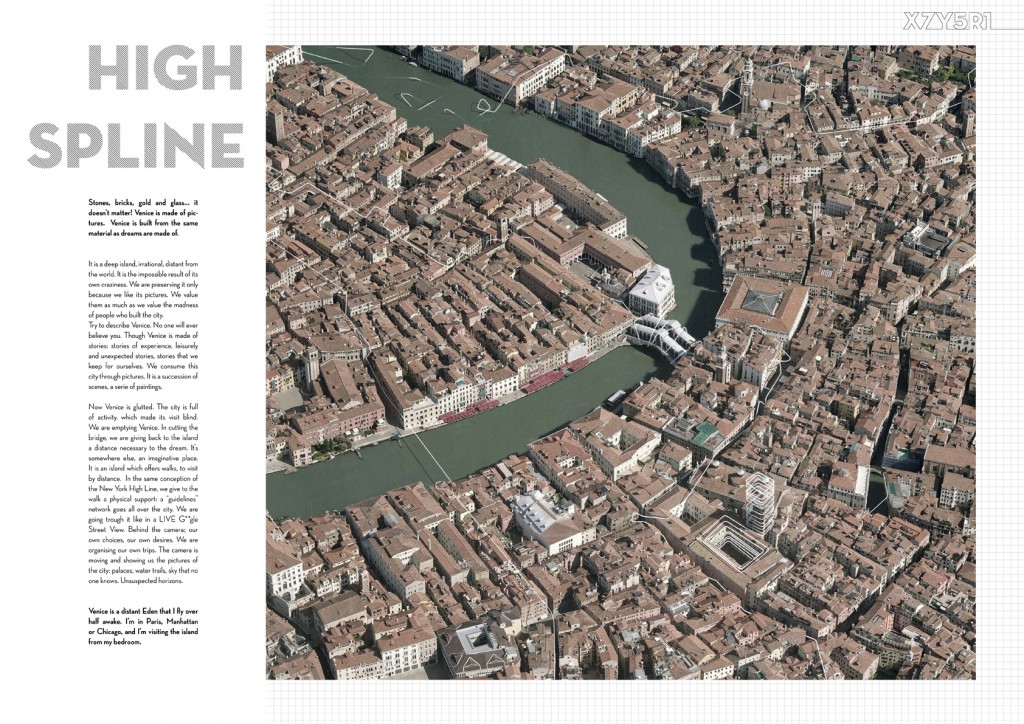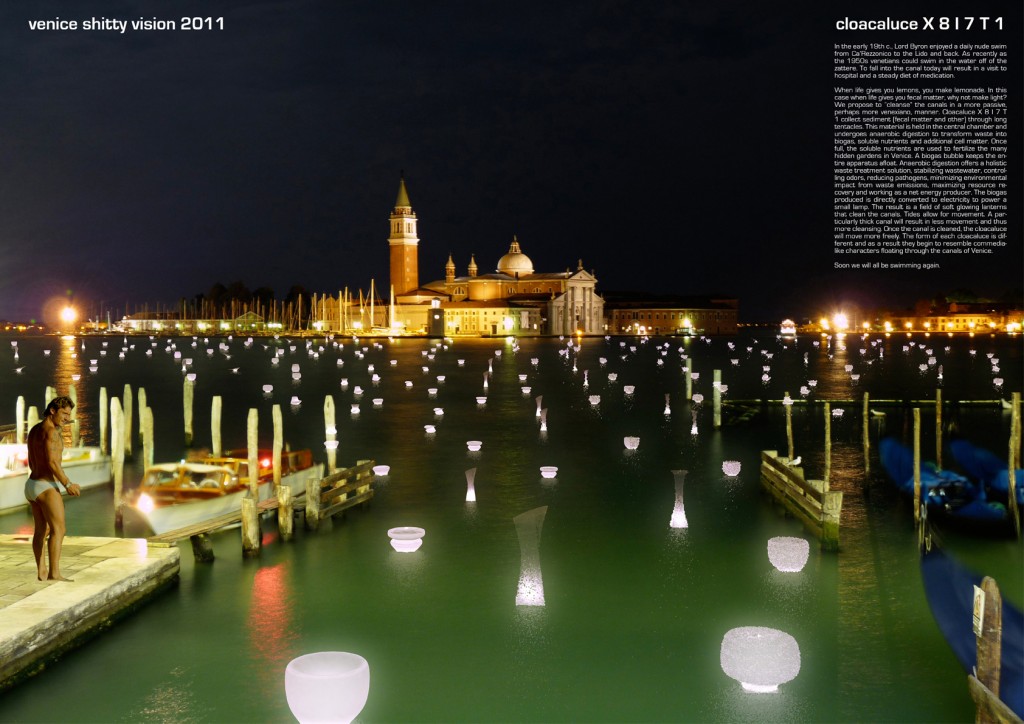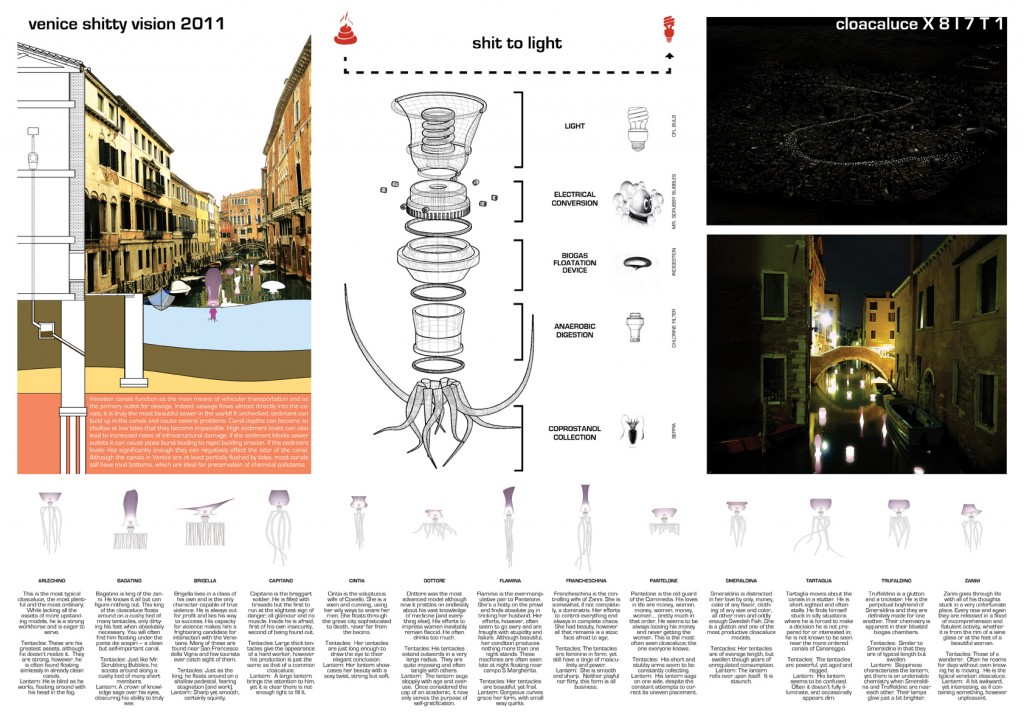Info:
Title: VENEZIA - Code: X8I7T1Contest: Venice / 2011
By: M. J. Neveu / F. Rafaie / M. Suba / K. Worl / A. Yue
Views: 2701 Likes: 1
Votes:
BJARKE INGELS11 NERI OXMAN4 ELENA MANFERDINI5 MARIA LUDOVICA TRAMONTIN7 BOSTJAN VUGA76.8
VENEZIA
In the early 19th c., Lord Byron enjoyed a daily nude swim from Ca’Rezzonico to the Lido and back. As recently as the 1950s venetians could swim in the water off of the zattere. To fall into the canal today will result in a visit to hospital and a steady diet of medication. Venetian canals function as the main means of vehicular transportation and as the primary outlet for sewage. Indeed, sewage flows almost directly into the canals; it is truly the most beautiful sewer in the world! If unchecked, sediment can build up in the canals and cause several problems. Canal depths can become so shallow at low tides that they become impassible. High sediment levels can also lead to increased rates of infrastructural damage.
If the sediment blocks sewer outlets it can cause pipes burst leading to rapid building erosion. If the sediment levels rise significantly enough they can negatively affect the odor of the canal. Maybe you have noticed? Although the canals in Venice are at least partially flushed by tides, most canals still have mud bottoms, which are ideal for preservation of chemical pollutants. The fecal sterol, coprostanol, generally shows much higher concentrations in the interior canals of Venice.
When sediment levels become too high, canals are sectioned off, drained and the sediment removed. Maintenance has been erratic through the 20th c., including an over thirty year hiatus of any maintenance. As a result, Venice suffered many problems and eventually Insula was formed in the mid 1990s to perform needed maintenance to the canals. As of 2008, Insula has dredged 71% of the canals, restored 56% of the embankments, rebuilt 29% of the pavements, and restored 55% of the bridges. In 2006 alone 388,000 cubic meters of excess sedimentation was removed. Due to recent shifts in public funding (specifically the MOSE project), however, money used to support Insula has been drastically reduced and thus the dredging of canals has become financially unfeasible. The sediment, however, continues to rise.
When life gives you lemons, you make lemonade. In this case when life gives you fecal matter, why not make light? We propose to “cleanse” the canals in a more passive, perhaps more venexiano, manner. Cloacaluce X 8 I 7 T 1 collect sediment (fecal matter and other) through long tentacles. This material is held in the central chamber and undergoes anaerobic digestion to transform waste into biogas, soluble nutrients and additional cell matter. Once full, the soluble nutrients are used to fertilize the many hidden gardens in Venice. A biogas bubble keeps the entire apparatus afloat. Anaerobic digestion offers a holistic waste treatment solution, stabilizing wastewater, controlling odors, reducing pathogens, minimizing environmental impact from waste emissions, maximizing resource recovery and working as a net energy producer. The biogas produced is directly converted to electricity to power a small lamp. The result is a field of soft glowing lanterns that clean the canals. Tides allow for movement. A particularly thick canal will result in less movement and thus more cleansing. Once the canal is cleaned, the cloacaluce will move more.
Info:
Title: VENEZIA
Time: 6 giugno 2011
Category: Venice
Views: 2701 Likes: 1
Tags: A. Yue , F. Rafaie , K. Worl , M. J. Neveu , M. Suba








